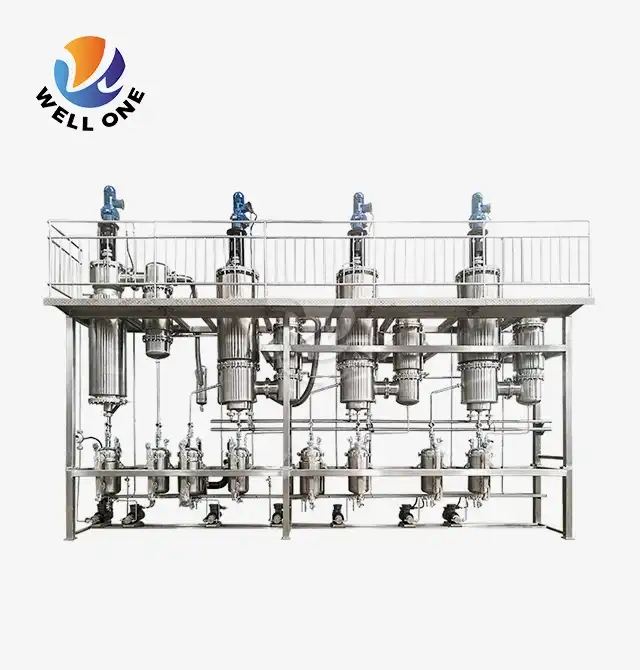How to Operate and Maintain a Short Path Distillation Unit?
A short path distillation unit is a specialized piece of laboratory glassware used to purify compounds and separate chemical mixtures through vacuum distillation. Compared to conventional distillation, a short path distillation apparatus can achieve higher purity products by utilizing a shortened vapor path length and high vacuum pressure. The key components include a specialized boiling flask, fractional distillation head, vacuum source, condenser, and collection vessels. Properly operating and maintaining these elements is crucial for ensuring optimal performance and producing the desired distillate fractions.
Understanding the setup, usage, and care procedures of a short path unit is important for chemists, lab technicians, and researchers alike. When utilized correctly, these versatile distillation systems can efficiently purify thermally sensitive compounds, concentrate dilute solutions, isolate reaction products, and collect multiple distillate fractions for further analysis. This article will explore the key steps involved in operating and preserving short path distillation units to support effective usage and maximize apparatus longevity.
Setting Up the Short Path Distillation Unit
Prior to starting the distillation process, the short path unit must be properly assembled within a stable support structure with adequate workspace. The main glassware components including the boiling flask, cow condenser, and receiving flasks are carefully clamped in place over a magnetic stirrer/hot plate. An insulated heating mantle connected to a variable voltage power supply surrounds the round bottom flask while the vertical condenser attaches via ground glass joints.
The sophisticated fractional distillation head with short vapor ducts ranging from 5-10 cm connects to the boiling flask and vacuum pump through specialized clamps and rubber tubing. A cold trap may also attach inline to collect residual contaminants. All ground glass joints must be properly greased and secured with spring clamps to prevent vacuum leaks. The hanging mercury or digital vacuum gauge should indicate readings within the expected pressure parameters when the pump operates.
All electrical equipment including the heating mantle, stirrer/hot plate, and vacuum pump should be grounded and connected to a surge protector. Never overload the electrical circuits which could blow fuses or circuit breakers. Always exercise caution when using glassware apparatus under vacuum pressure and extreme temperature conditions. Wear personal protective equipment like closed-toe shoes, lab coats, cryogenic gloves, and safety glasses. Ensure the workspace remains uncluttered, clean, and clear of obstructions before beginning distillation.
Operating the Short Path Distillation Unit
To begin distillation, the sample is placed in the round bottom flask along with a Teflon coated magnetic stir bar for mixing. The surrounding heating mantle raises the flask temperature to initiate boiling while the variable voltage power supply allows for precise temperature control. Vacuum pressure reduces the solvent boiling point, enabling lower temperature distillation. The short vapor ducts within the fractional distillation head provide a shortened path length for vapors to travel before condensing, enabling better separation.
As the vacuum pump operates, vapor travels upwards through the distillation head, condenses into liquid form within the vertical condenser, then collects in the receiving flask. thermocouple probes monitor the vapor temperature inside the distillation head and liquid temperature exiting the condenser. The user manually adjusts distillation parameters like vacuum pressure, heating mantle voltage, stir rate, and collection flask replacement at appropriate intervals to maintain steady reflux conditions. Careful observation of the process is imperative to prevent overflow of the boiling flask or freezing/clogging issues within the condenser.
Maintaining the Short Path Distillation Unit
Routine maintenance preserves the longevity, safety, and performance capabilities of a short path distillation system. Before and after each use, the glassware apparatus should be emptied, thoroughly cleaned with a solvent like acetone or isopropyl alcohol, then dried completely. Inspect all rubber stoppers, tubing, and vacuum grease connections for deterioration or leaks and replace damaged components as needed. Check the ground glass joints sealing the boiling flask and condenser for chips, cracks, or etching marks. Re-grease the joints before reconnecting the glassware.
Periodically lubricate stopcocks, control valves, and vacuum pump mechanical parts per the manufacturer's guidelines to prevent seizing up. Calibrate the digital vacuum and temperature sensors at least once per year. Inspect heating mantles, stir plates, and other electrical accessories for fraying wires or damage. Replace any worn-out electrical components to avoid potential shock or fire hazards. Monitor glassware for cloudiness, scratches, or weak points that reduce structural integrity under vacuum conditions. Etching marks on boiling flasks or condensers should prompt replacement of the damaged glassware. Follow all equipment troubleshooting, repair, and maintenance instructions provided in user manuals.
Troubleshooting Common Issues
Despite best practices for setup, operation, and maintenance - short path distillation systems can still encounter problems. Insufficient vacuum pressure, leaks, overheating, clogging, or abnormal distillation rates indicate underlying issues that should be promptly corrected. Always turn off and unplug the apparatus before attempting troubleshooting procedures. Common solutions involve checking the vacuum grease seals for leakage, replacing worn vacuum pump oil, inspecting glassware joints for cracks, cleaning condenser coiling, or recalibrating digital temperature controllers.
Seeking professional assistance from experienced technicians or factory representatives may prove necessary to diagnose complex mechanical, electrical, and instrumentation failures. Always reference user manuals when encountering safety hazards, error codes, or equipment malfunctions during the distillation process. For specific troubleshooting advice pertaining to individual short path distillation units, consult the manufacturer's guidelines or reach out to technical specialists. Taking proper corrective actions facilitates safer and more effective distillation moving forward.
Safety Measures
When dealing with hazardous chemicals, reactive compounds, flammable solvents, or extreme temperature glassware - short path distillation safety warrants strict adherence. Always use personal protective equipment, maintain a clean workspace, follow chemical handling best practices, and take proper precautionary measures. Refer to safety data sheets when working with volatile, toxic, or unknown substances to better understand proper handling techniques, potential health hazards, recommended PPE, and emergency procedures.
Set up a fume hood or well-ventilated area when distilling flammable solvents or volatile chemicals. Post appropriate laboratory safety signage and ensure fire extinguishers, first aid kids, and eye wash stations remain easily accessible. Frequently inspect glassware for defects before applying heat or vacuum pressure. Carefully clamp apparatus to prevent implosions or accidents caused by slipping joints or flasks. Seek training on handling vacuum systems, cryogenic materials, and other laboratory hazards associated with distillation. Following rigorous safety protocols reduces the likelihood of personal injuries, environmental incidents, or property damage.
Conclusion
While powerful tools for purification and separation, short path distillation systems require diligent operating and maintenance practices to sustain performance, safety, and longevity. Carefully assembling the glassware components under vacuum tight conditions prevents leaks or fractures. Meticulous distillation process monitoring enables high purity fraction collection. Consistent apparatus cleaning and repairs maintains proper functioning. Referencing equipment manuals, troubleshooting issues promptly, adhering to safety guidelines - all support the effective utilization of short path distillation units. With the right techniques and responsible operating procedures, these versatile laboratory instruments can continue producing high-quality distillate products over many years of service.
Xi'an Well One Chemical Technology Co., Ltd, established in 2006, is a leading provider of chemical equipment solutions. As a subsidiary of Xi'an NewSet Chemical Equipment Technology Co., Ltd, we have 17 years of production and manufacturing experience. Our facilities, located in the Sanyuan Precision Equipment Industrial Park in Xi'an, Shaanxi, include a 1500 square meter office building, a 500 square meter research and development analysis laboratory, and a 4500 square meter equipment processing and manufacturing factory. Our senior design team and processing and manufacturing team, which includes experts in process development, equipment design, and 3D modeling, are dedicated to researching and producing innovative synthesis and purification separation equipment. We provide comprehensive services to our customers, including feasibility research, process development, laboratory testing, and pilot testing, ensuring that our customers' production equipment meets their production capacity and product quality requirements. Our product range includes experimental level, pilot level, and industrial level molecular distillation devices, as well as multi-level continuous use systems. As a Short Path Distillation Unit supplier, we are confident in providing high-quality equipment at the most appropriate price. For inquiries, please contact our professional team at Mobile: (+86) 18191320360 or Email: info@welloneupe.com. We are committed to serving you wholeheartedly.
References
Eggers, D., & Funk, E. (2014). Short path distillation - State of the art. Separation and Purification Reviews, 43(3), 245-262.
Nilsson, W., & Hudson, J. (2013). Operating characteristics, applications, and advantages of short path distillation systems. ISRN Chemical Engineering, 2013, 1-29.
Pope, C.G. (2001). Rules of thumb for chemical engineers: A manual of quick, accurate solutions to everyday process engineering problems. Gulf Professional Publishing.







